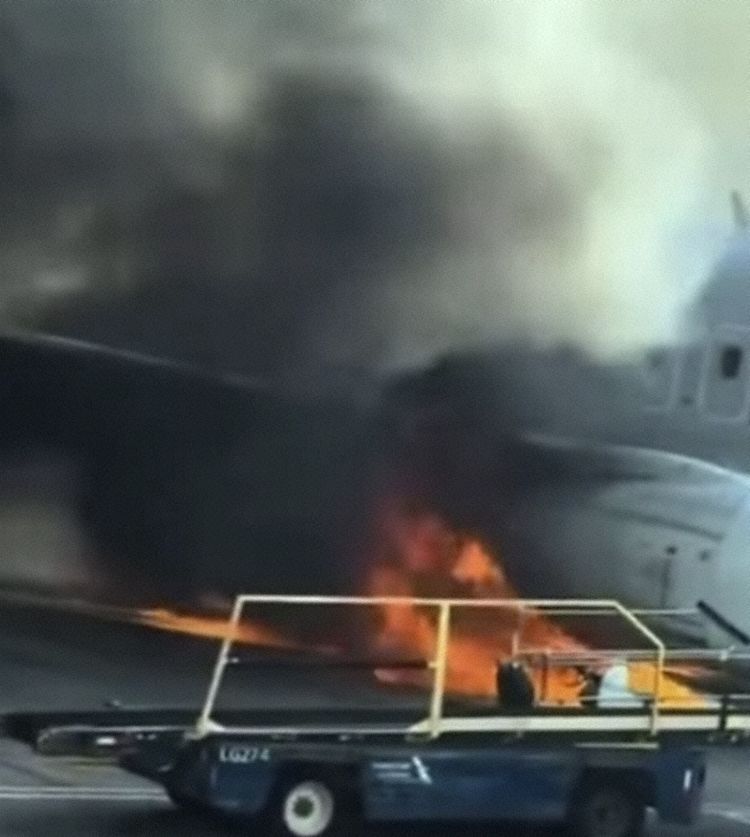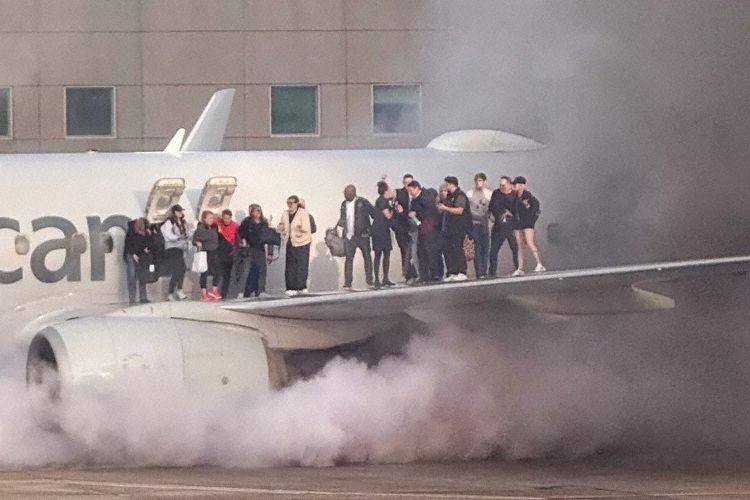An American Airlines Boeing 737-800, registration N885NN performing flight AA-1006 from Colorado Springs,CO to Dallas Ft. Worth,TX (USA) with 172 passengers and 6 crew, was climbing out of Colorado Springs, when the crew stopped the climb at about 16000 feet reporting right hand engine (CFM56) vibrations and decided to divert to Denver,CO (USA), where the aircraft landed safely on runway 16R about one hour after departure. The aircraft taxied to the apron. At the gate the right hand engine caught fire prompting an emergency evacuation via slides. The fire was put out by emergency services. 12 passengers were taken to local hospitals with minor injuries.
The FAA reported: "American Airlines Flight 1006 diverted to and landed safely at Denver International Airport around 5:15 p.m. local time on Thursday, March 13, after the crew reported engine vibrations. After landing and while taxiing to the gate an engine caught fire and passengers evacuated the aircraft using the slides. The Boeing 737-800 departed Colorado Springs Airport and was headed to Dallas Fort Worth International Airport. The FAA will investigate."
The airport later reported 12 people were taken to hospitals with minor injuries.
Subsequently the FAA reported 12 passengers received minor injuries.
The NTSB announced: "NTSB is investigating a March 13 incident involving an American Airlines operated Boeing 737-800 that made an emergency landing in Denver, Colorado due to engine concerns."
A replacement Boeing 737-8 MAX registration N304RB reached Dallas with a delay of about 7.5 hours.
On Jun 5th 2025 the NTSB released their preliminary report summarizing the sequence of events:
On March 13, 2025, about 1759 mountain daylight time, American Airlines flight 1006, Boeing 737-823, N885NN, experienced engine vibrations during takeoff from Colorado Springs Airport (COS), Colorado Springs, Colorado. The flight crew continued the takeoff, then diverted to and landed at Denver International Airport (DEN), Denver, Colorado. After landing, the flight crew taxied to their assigned gate and both engines were shutdown. After shutdown, a fire ensued in the area of the No. 2 (right) engine and the passengers and crew evacuated the airplane.
The fire was extinguished within 1 minute by gate ramp personnel, prior to the arrival of the DEN aircraft fire fighting and rescue (ARFF). Of the three trucks that arrived, one truck, positioned toward the right side of the airplane sprayed water on the right aft fuselage area and right inboard wing hot spots (areas indicated by their infrared heat sensors).
Video provided by DEN airport operations showed a trail of fluid leaking from under the right engine nacelle as the airplane taxied into the gate.
The flight was operated under the provisions of Title 14 Code of Federal Regulations Part 121 as a scheduled domestic passenger flight from COS to Dallas Fort Worth International Airport (DFW). There were 2 flight crew, 4 cabin crew and 172 passengers on board. Twelve passengers received minor injuries. The airplane received substantial damage. Visual meteorological conditions prevailed at the time of the accident.
The first officer (FO) was the pilot flying, and the captain was the pilot monitoring. According to the flight crew, during takeoff and just before V1 there was an EGT over-temp for the No. 2 engine. After gear and flaps were retracted, the power was slightly reduced on the No. 2 engine and the EGT over-temp subsided to within limits.
During climbout, the captain noted high engine vibration indications for the right engine (No. 2). The captain called for the High Engine Vibration checklist and the FO continued to fly the airplane. The flight crew discussed the need to divert and contacted American Airlines dispatch. It was determined that DEN would be the most reasonable airport to divert to. The crew climbed to 16,000 feet msl, which was the highest altitude reached for the flight.
The captain informed the passengers and the flight attendants that the flight was diverting to DEN. Approach and landing were normal, and it took about five minutes to taxi to the gate. Soon after arriving at the gate, flight attendants heard passengers yelling fire and smoke and saw smoke start to the fill the cabin. One of the flight attendants tried calling the flight crew but did not get an answer. Another flight attendant knocked on the cockpit door to alert the flight crew of the fire outside the airplane and smoke in the cabin. In the meantime, passengers got up and were coming to the flight attendants wanting to get off the airplane. The flight attendants conducted their assessments and initiated an evacuation.
Passengers used the L1 door, both left overwing window exits, and the R2 door for egress. The passengers who used the L1 door deplaned using the jetway bridge. After the evacuation, the L2 door was observed cracked open, with maintenance subsequently discovering the escape slide jammed in the door, preventing its operation. The R2 evacuation slide deployed automatically when the R2 door was opened.
The passengers who used the left overwing window exits were evacuated off the wing by a combination of ground vehicles, ladders that were available in the gate area, and a belt loader. Post event examination found the flaps had remained at zero.
The NTSB further stated:
The airplane was powered by two CFM56-7B turbofan engines. The right engine was examined and all the engine fan blades were present, but one fan blade platform was fractured. In addition, the lockwire of a fuel fitting on the variable stator vane (VSV) was loose and installed in the incorrect direction. The VSV actuator rod end was incorrectly fastened and secured to the VSV actuator allowing fuel to leak from the fitting. The VSV rod end muscle line was fractured in the weld, and the 6 oclock seal drain line of the inboard thrust reverser half was blocked with sealant above the lower bifurcation fire seal and in the exit tube.
The L2 slide was found removed from its bustle and on the floor of the L2 passageway with its safety pin installed. The slide pack was inspected and the bannis latch was found to move freely. There were some dark scuffs on the outboard side of the pack, and there was a tear on the underside of the girt fabric towards the center.
https://flightaware.com/live/flight/AAL1006/history/20250313/2250Z/KCOS/KDFW
The right hand engine at the gate:

Passengers on the wing during evacuation:

The FAA reported: "American Airlines Flight 1006 diverted to and landed safely at Denver International Airport around 5:15 p.m. local time on Thursday, March 13, after the crew reported engine vibrations. After landing and while taxiing to the gate an engine caught fire and passengers evacuated the aircraft using the slides. The Boeing 737-800 departed Colorado Springs Airport and was headed to Dallas Fort Worth International Airport. The FAA will investigate."
The airport later reported 12 people were taken to hospitals with minor injuries.
Subsequently the FAA reported 12 passengers received minor injuries.
The NTSB announced: "NTSB is investigating a March 13 incident involving an American Airlines operated Boeing 737-800 that made an emergency landing in Denver, Colorado due to engine concerns."
A replacement Boeing 737-8 MAX registration N304RB reached Dallas with a delay of about 7.5 hours.
On Jun 5th 2025 the NTSB released their preliminary report summarizing the sequence of events:
On March 13, 2025, about 1759 mountain daylight time, American Airlines flight 1006, Boeing 737-823, N885NN, experienced engine vibrations during takeoff from Colorado Springs Airport (COS), Colorado Springs, Colorado. The flight crew continued the takeoff, then diverted to and landed at Denver International Airport (DEN), Denver, Colorado. After landing, the flight crew taxied to their assigned gate and both engines were shutdown. After shutdown, a fire ensued in the area of the No. 2 (right) engine and the passengers and crew evacuated the airplane.
The fire was extinguished within 1 minute by gate ramp personnel, prior to the arrival of the DEN aircraft fire fighting and rescue (ARFF). Of the three trucks that arrived, one truck, positioned toward the right side of the airplane sprayed water on the right aft fuselage area and right inboard wing hot spots (areas indicated by their infrared heat sensors).
Video provided by DEN airport operations showed a trail of fluid leaking from under the right engine nacelle as the airplane taxied into the gate.
The flight was operated under the provisions of Title 14 Code of Federal Regulations Part 121 as a scheduled domestic passenger flight from COS to Dallas Fort Worth International Airport (DFW). There were 2 flight crew, 4 cabin crew and 172 passengers on board. Twelve passengers received minor injuries. The airplane received substantial damage. Visual meteorological conditions prevailed at the time of the accident.
The first officer (FO) was the pilot flying, and the captain was the pilot monitoring. According to the flight crew, during takeoff and just before V1 there was an EGT over-temp for the No. 2 engine. After gear and flaps were retracted, the power was slightly reduced on the No. 2 engine and the EGT over-temp subsided to within limits.
During climbout, the captain noted high engine vibration indications for the right engine (No. 2). The captain called for the High Engine Vibration checklist and the FO continued to fly the airplane. The flight crew discussed the need to divert and contacted American Airlines dispatch. It was determined that DEN would be the most reasonable airport to divert to. The crew climbed to 16,000 feet msl, which was the highest altitude reached for the flight.
The captain informed the passengers and the flight attendants that the flight was diverting to DEN. Approach and landing were normal, and it took about five minutes to taxi to the gate. Soon after arriving at the gate, flight attendants heard passengers yelling fire and smoke and saw smoke start to the fill the cabin. One of the flight attendants tried calling the flight crew but did not get an answer. Another flight attendant knocked on the cockpit door to alert the flight crew of the fire outside the airplane and smoke in the cabin. In the meantime, passengers got up and were coming to the flight attendants wanting to get off the airplane. The flight attendants conducted their assessments and initiated an evacuation.
Passengers used the L1 door, both left overwing window exits, and the R2 door for egress. The passengers who used the L1 door deplaned using the jetway bridge. After the evacuation, the L2 door was observed cracked open, with maintenance subsequently discovering the escape slide jammed in the door, preventing its operation. The R2 evacuation slide deployed automatically when the R2 door was opened.
The passengers who used the left overwing window exits were evacuated off the wing by a combination of ground vehicles, ladders that were available in the gate area, and a belt loader. Post event examination found the flaps had remained at zero.
The NTSB further stated:
The airplane was powered by two CFM56-7B turbofan engines. The right engine was examined and all the engine fan blades were present, but one fan blade platform was fractured. In addition, the lockwire of a fuel fitting on the variable stator vane (VSV) was loose and installed in the incorrect direction. The VSV actuator rod end was incorrectly fastened and secured to the VSV actuator allowing fuel to leak from the fitting. The VSV rod end muscle line was fractured in the weld, and the 6 oclock seal drain line of the inboard thrust reverser half was blocked with sealant above the lower bifurcation fire seal and in the exit tube.
The L2 slide was found removed from its bustle and on the floor of the L2 passageway with its safety pin installed. The slide pack was inspected and the bannis latch was found to move freely. There were some dark scuffs on the outboard side of the pack, and there was a tear on the underside of the girt fabric towards the center.
https://flightaware.com/live/flight/AAL1006/history/20250313/2250Z/KCOS/KDFW
The right hand engine at the gate:

Passengers on the wing during evacuation:

This article is published under license. Article Source
Published Date















